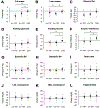Effects of 4- and 6-h Time-Restricted Feeding on Weight and Cardiometabolic Health: A Randomized Controlled Trial in Adults with Obesity
- PMID: 32673591
- PMCID: PMC9407646
- DOI: 10.1016/j.cmet.2020.06.018
Effects of 4- and 6-h Time-Restricted Feeding on Weight and Cardiometabolic Health: A Randomized Controlled Trial in Adults with Obesity
Abstract
Time-restricted feeding (TRF) regimens have grown in popularity; however, very few studies have examined their weight-loss efficacy. We conducted the first human trial (Clinicaltrials.gov NCT03867773) to compare the effects of two popular forms of TRF (4 and 6 h) on body weight and cardiometabolic risk factors. Adults with obesity were randomized to 4-h TRF (eating only between 3 and 7 p.m.), 6-h TRF (eating only between 1 and 7 p.m.), or a control group (no meal timing restrictions). After 8 weeks, 4- and 6-h TRF produced comparable reductions in body weight (∼3%), insulin resistance, and oxidative stress, versus controls. Energy intake was reduced by ∼550 kcal/day in both TRF groups, without calorie counting. These findings suggest that 4- and 6-h TRF induce mild reductions in body weight over 8 weeks and show promise as interventions for weight loss. These diets may also improve some aspects of cardiometabolic health.
Keywords: blood pressure; body weight; energy intake; insulin resistance; intermittent fasting; metabolic disease; obesity; plasma lipids; time-restricted feeding.
Copyright © 2020 Elsevier Inc. All rights reserved.
Conflict of interest statement
Declaration of Interests K.A.V. received author fees from Hachette Book Group for the book The Every-Other-Day Diet. The other authors declare no competing interests.
Figures






Comment in
-
Intermittent fasting passes trial.Nat Med. 2020 Aug;26(8):1170. doi: 10.1038/s41591-020-1030-1. Nat Med. 2020. PMID: 32770161 No abstract available.
References
-
- Antoni R, Johnston KL, Collins AL, and Robertson MD (2018). Intermittent v. continuous energy restriction: differential effects on postprandial glucose and lipid metabolism following matched weight loss in overweight/obese participants. Br J Nutr 119, 507–516. - PubMed
-
- Antoni R, Robertson TM, Robertson MD, Johnston JD (2018). A pilot feasibility study exploring the effects of a moderate time-restricted feeding intervention on energy intake, adiposity and metabolic physiology in free-living human subjects. J Nutr Sci 7, 22.
-
- Bhutani S, Klempel MC, Kroeger CM, Trepanowski JF, and Varady KA (2013). Alternate day fasting and endurance exercise combine to reduce body weight and favorably alter plasma lipids in obese humans. Obesity (Silver Spring) 21, 1370–1379. - PubMed
-
- Carlson O, Martin B, Stote KS, Golden E, Maudsley S, Najjar SS, Ferrucci L, Ingram DK, Longo DL, Rumpler WV, et al. (2007). Impact of reduced meal frequency without caloric restriction on glucose regulation in healthy, normal-weight middle- aged men and women. Metabolism 56, 1729–1734. - PMC - PubMed
Publication types
MeSH terms
Associated data
Grants and funding
LinkOut - more resources
Full Text Sources
Medical

